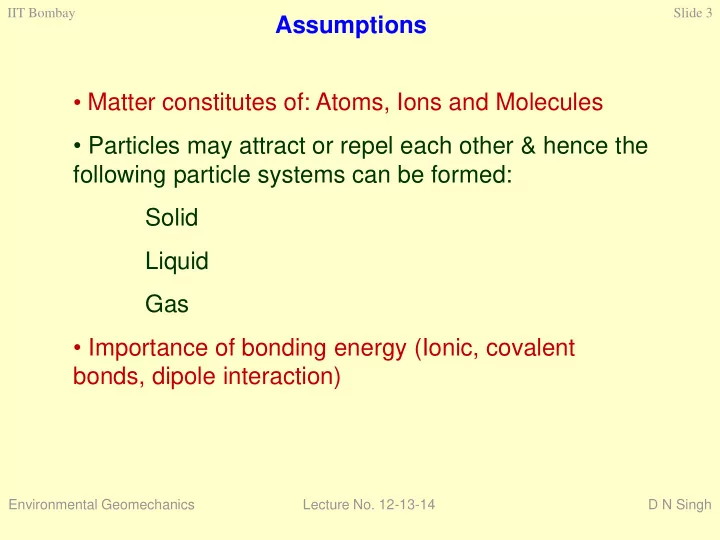

IIT Bombay Slide 3 Assumptions • Matter constitutes of: Atoms, Ions and Molecules • Particles may attract or repel each other & hence the following particle systems can be formed: Solid Liquid Gas • Importance of bonding energy (Ionic, covalent bonds, dipole interaction) Environmental Geomechanics Lecture No. 12-13-14 D N Singh
IIT Bombay Slide 4 Elementary particles Element is composed of atoms (e, p, n) Cations Mg +2 , Na + Neutral , Charged (ions) Anions Cl - , O -2 Simple ions Atoms Na, Mg, C, N, O, H -2 ,NO 3 - , OH - Poly atom ions CO 3 Sharing of a pair of electrons binds atoms together a new kind of particle Molecule CH 4 , NH 3 , HCl , Environmental Geomechanics Lecture No. 12-13-14 D N Singh
IIT Bombay Slide 5 Particle Systems Solid Liquid Gas Dry Soil Single phase system Saturated soil Two phase system Partially saturated Soil Three phase system Stress-strain relationship (Load-Deformation process) depends on the binding behavior of two or more particles Flow of water through the soil & water content Are dependent on the energies between particles Environmental Geomechanics Lecture No. 12-13-14 D N Singh
IIT Bombay Slide 6 Phenomena of Solid-liquid-gas at interface Gas-gas Single phase interface Solid-solid Liquid-liquid Two phase interface Solid-liquid Solid-gas Gas-Liquid Multiphase interface Solid-liquid-gas Environmental Geomechanics Lecture No. 12-13-14 D N Singh
IIT Bombay Slide 7 Types of Energy Fields Particles react differently in various energy fields Surface Mechanical Energy Field (K.E. and P.E.) force & Body force Most widely used in Geotechnical Engg. (Gravity) Loading of soil mass results in high density & low volume (combination of K.E., P.E., Thermal Energy (friction between particles), Sound & Light Energies----due to crushing of grains) Total Energy of the soil mass changes (i.e. change in orientation of soil particles) Compression of gases in voids, more dissolution of gases in pore solution, elastic strains of soil grains, characteristics of double layer Environmental Geomechanics Lecture No. 12-13-14 D N Singh
IIT Bombay Slide 8 Types of Energy Fields Particles react differently in various energy fields Surface Mechanical Energy Field (K.E. and P.E.) force & Body force (Gravity) Thermal Energy Field Electrical Energy Field Long-term interaction Magnetic Energy Field Radiation Energy Field Environmental Geomechanics Lecture No. 12-13-14 D N Singh
IIT Bombay Slide 9 Mechanical Energy Field Potential Energy (Position) and Kinetic Energy (Motion) Potential Energy is stored within a physical system. Can be released or converted into other forms of energy, say Kinetic Energy. Types of PE: (each is associated with a particular kind of force). Elastic force is Elastic Potential Energy. Gravitational force is Gravitational Potential Energy Coulomb force is Electric Potential Energy Nuclear force is Nuclear Potential Energy Environmental Geomechanics Lecture No. 12-13-14 D N Singh
IIT Bombay Slide 10 Potential Energy Compaction Consolidation Distortion Bending Crushing Kneading Shearing Kinetic Energy Movement of water through porous media Vibration Environmental Geomechanics Lecture No. 12-13-14 D N Singh
IIT Bombay Slide 11 Mechanical Energy Field • All short term processes • Ignore influence of the Environment Load, Deformation, Velocity, Weight, Mass, Wave, Sound Foundation design Governing Laws Flow through porous media Acid rains • Darcy’s Toxic/Hazardous wastes • Hook’s Nuclear waste storage/containment • Newton’s Land slides • Law of motion Earthquakes Environmental Geomechanics Lecture No. 12-13-14 D N Singh
IIT Bombay Slide 12 Thermal Energy Field • Includes the influence of the Environment Hydration, Heat of Wetting, Heat of Contact, Heat of sublimation, Thermo-osmosis Freeze-thaw Governing Laws Wetting-drying cycle Fire in mines/underground • Gas law Thermal/ Desiccation cracks • Fourier’s law • Laws of Thermodynamics Environmental Geomechanics Lecture No. 12-13-14 D N Singh
IIT Bombay Slide 13 Basic characteristics of Thermal Energy Field Additional forces are produced when water is added to dry or partially saturated soils ---Environmental forces/stresses Heat transfer due to thermal field affects soil-water-air behavior State of matter, existing in the thermal energy field, changes as a function of change in temperature Liquid to Gas (Heat of Vaporization) Liquid to Solid (Heat of Fusion) Solid to Gas (Heat of Sublimation) Depends upon Energy input/release Environmental Geomechanics Lecture No. 12-13-14 D N Singh
IIT Bombay Slide 14 Electrical Energy Field • Includes the influence of the Environment Polarization, Electromotive force, Electrical conductivity Creep Viscosity Governing Laws Stress hardening & softening Aging effect • Coulomb's law Contaminant Migration • Joule’s law Site-remediation • Ohm’s laws Electro-kinetics • Ampere’s law Electro-osmosis Environmental Geomechanics Lecture No. 12-13-14 D N Singh
IIT Bombay Slide 15 Magnetic Energy Field • Includes the influence of the Environment Electromagnet, Ferro-magnet, Electromagnetic induction, Electromagnetic waves FDR/TDR probes Governing Laws For soil mass characterization Volumetric moisture content • Faraday's law • Lenz’s law • Bio- savart’s law • Gauss’s law Environmental Geomechanics Lecture No. 12-13-14 D N Singh
IIT Bombay Slide 16 Applications of Electromagnetic Field Various disciplines. X-rays are high frequency electromagnetic radiations and are used in radio astronomy, radiography in medicine and radiometry in tele-communications Laser therapy, which is an example of photo-medicine. Applications of Lasers: Laser-guided bombs Barcode readers Laser therapy Environmental Geomechanics Lecture No. 12-13-14 D N Singh
IIT Bombay Slide 17 Radiation Energy Field • Includes the influence of the Environment Decay process, Radioactivity, Nuclear reaction Governing Laws • Nuclear physics • Atomic physics Environmental Geomechanics Lecture No. 12-13-14 D N Singh
Environment IIT Bombay Slide 18 (Natural and Man Made) Mechanical Energy Field Radiation Energy Field 1 3 4 Electrical Energy Field Magnetic Energy Field 2 Thermal Energy Field 1 Electro-viscous effect 2 Thermo-Electric effect 3 Electro-magnetic effect 4 Electro-magnetic radiation Environmental Geomechanics Lecture No. 12-13-14 D N Singh
Recommend
More recommend